
Actuarial science is the discipline that applies mathematical and statistical methods to assess risk in insurance, pension, finance, investment and other industries and professions. More generally, actuaries apply rigorous mathematics to model matters of uncertainty and life expectancy.

The First Barbary War (1801–1805), also known as the Tripolitan War and the Barbary Coast War, was a conflict during the Barbary Wars, in which the United States and Sweden fought against Tripolitania. Tripolitania had declared war against Sweden and the United States over disputes regarding tributary payments made by both states in exchange for a cessation of Tripolitatian commerce raiding at sea. United States President Thomas Jefferson refused to pay this tribute. Sweden had been at war with the Tripolitans since 1800. The First Barbary War was the first major American war fought outside the New World, and in the Arab world.
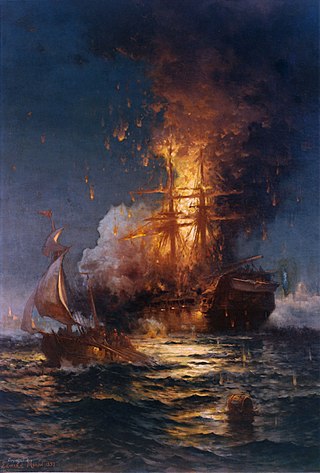
The Barbary Wars were a series of two wars fought by the United States, Sweden, and the Kingdom of Sicily against the Barbary states and Morocco of North Africa in the early 19th century. Sweden had been at war with the Tripolitans since 1800 and was joined by the newly independent US. The First Barbary War extended from 10 May 1801 to 10 June 1805, with the Second Barbary War lasting only three days, ending on 19 June 1815. The Barbary Wars were the first major American war fought entirely outside the New World, and in the Arab World.

The Second Barbary War (1815) or the U.S.–Algerian War was fought between the United States and the North African Barbary Coast states of Tripoli, Tunis, and Algiers. The war ended when the United States Senate ratified Commodore Stephen Decatur's Algerian treaty on 5 December 1815. However, Dey Omar Agha of Algeria repudiated the US treaty, refused to accept the terms of peace that had been ratified by the Congress of Vienna, and threatened the lives of all Christian inhabitants of Algiers. William Shaler was the US commissioner in Algiers who had negotiated alongside Decatur, but he fled aboard British vessels during the 1816 bombardment of Algiers. He negotiated a new treaty in 1816 which was not ratified by the Senate until 11 February 1822, because of an oversight.

Life insurance is a contract between an insurance policy holder and an insurer or assurer, where the insurer promises to pay a designated beneficiary a sum of money upon the death of an insured person. Depending on the contract, other events such as terminal illness or critical illness can also trigger payment. The policyholder typically pays a premium, either regularly or as one lump sum. The benefits may include other expenses, such as funeral expenses.
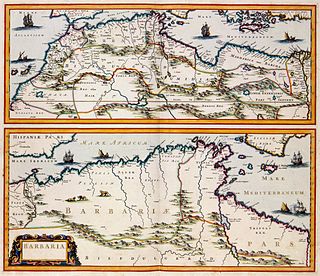
The Barbary Coast was the name given to the coastal regions of central and western North Africa or more specifically the Maghreb and the Ottoman borderlands consisting of the regencies in Algiers, Tunis, and Tripoli, as well as the Sultanate of Morocco from the 16th to 19th centuries. The term originates from the exonym of the Berbers.

The Barbary pirates, Barbary corsairs, or Ottoman corsairs were mainly Muslim pirates and privateers who operated from the Barbary states. This area was known in Europe as the Barbary Coast, in reference to the Berbers. Slaves in Barbary could be of many ethnicities, and of many different religions, such as Christian, Jewish, or Muslim. Their predation extended throughout the Mediterranean, south along West Africa's Atlantic seaboard and into the North Atlantic as far north as Iceland, but they primarily operated in the western Mediterranean. In addition to seizing merchant ships, they engaged in razzias, raids on European coastal towns and villages, mainly in Italy, France, Spain, and Portugal, but also in the British Isles, the Netherlands, and Iceland.

Switzerland has universal health care, regulated by the Swiss Federal Law on Health Insurance. There are no free state-provided health services, but private health insurance is compulsory for all persons residing in Switzerland.
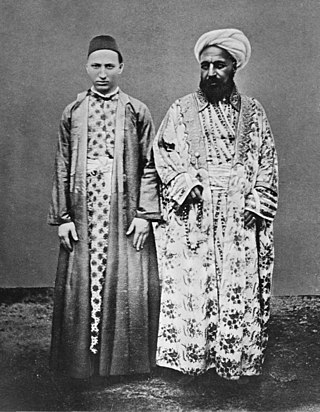
White slavery refers to the enslavement of any of the world's European ethnic groups throughout human history, whether perpetrated by non-Europeans or by other Europeans. Slavery in ancient Rome was frequently dependent on a person's socio-economic status and national affiliation, and thus included European slaves. It was also common for European people to be enslaved and traded in the Muslim world; European women, in particular, were highly sought-after to be concubines in the harems of many Muslim rulers. Examples of such slavery conducted in Islamic empires include the Arab slave trade, the Barbary slave trade, and the Black Sea slave trade, among others. It was common for Europeans to be traded alongside Africans, Turks, Iranians, and sometimes other Arabs.
The Maritime history of the United States (1776–1799) begins with the British colonists before 1776, American merchant vessels had enjoyed the protection of the Royal Navy. During the American Revolution, American ships came under the aegis of France due to a 1778 Treaty of Alliance between the two countries.

The Turkish Abductions were a series of slave raids by pirates from Algier that took place in Iceland in the summer of 1627.
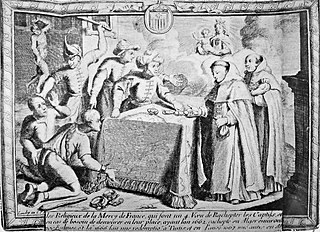
The Barbary slave trade involved the capture and selling of European slaves at slave markets in the Barbary states. European slaves were captured by Barbary pirates in slave raids on ships and by raids on coastal towns from Italy to the Netherlands, Ireland and the southwest of Britain, as far north as Iceland and into the Eastern Mediterranean.

The history of insurance traces the development of the modern business of insurance against risks, especially regarding cargo, property, death, automobile accidents, and medical treatment.
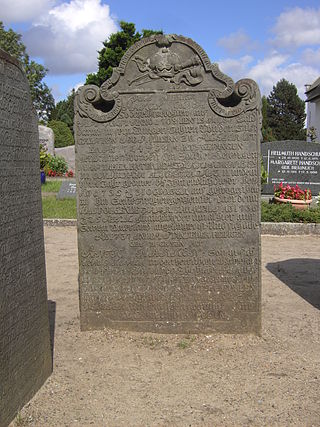
Hark Olufs was a North Frisian sailor. He was captured by Algerian pirates and sold into slavery. By successfully working as a slave servant to the Bey of Constantine, he eventually obtained his freedom from captivity.

The Hanseaten is a collective term for the hierarchy group consisting of elite individuals and families of prestigious rank who constituted the ruling class of the free imperial city of Hamburg, conjointly with the equal First Families of the free imperial cities of Bremen and Lübeck. The members of these First Families were the persons in possession of hereditary grand burghership of these cities, including the mayors, the senators, joint diplomats and the senior pastors. Hanseaten refers specifically to the ruling families of Hamburg, Lübeck and Bremen, but more broadly, this group is also referred to as patricians along with similar social groups elsewhere in continental Europe.
Pensions in Norway fall into three major divisions; State Pensions, Occupational Pensions and Individual or personal Pensions.
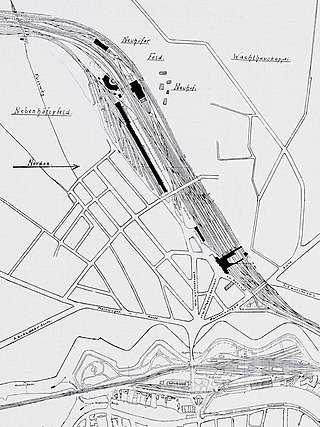
The Lübeck-Büchen Railway was a German railway company that built railway lines from Lübeck to Büchen and to Hamburg in the 19th century.

Neustadt is one of the inner-city districts of the Free and Hanseatic City of Hamburg, Germany.

The Great fire of Hamburg began early on May 5, 1842, in Deichstraße and burned until the morning of May 8, destroying about one third of the buildings in the Altstadt. It killed 51 people and destroyed 1,700 residences and several important public buildings, necessitating major civic rebuilding and prompting infrastructure improvements. The heavy demand on insurance companies led to the establishment of reinsurance.

Slavery existed in Morocco since antiquity until the 20th-century. Morocco was a center of the Trans-Saharan slave trade route of enslaved Black Africans from sub-Saharan Africa until the 20th-century, as well as a center of the slave trade of Barbary slave trade of Europeans captured by the barbary pirates until the 19th-century. The open slave trade was finnally suppressed in Morocco in the 1920s. The haratin and the gnawa have been referred to as descentants of former slaves.

















